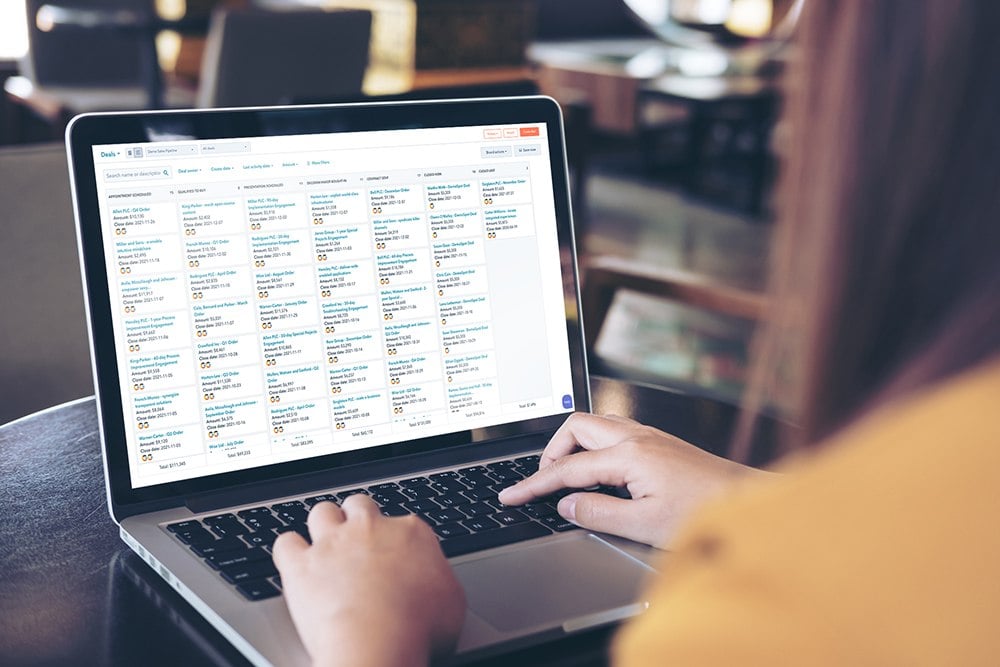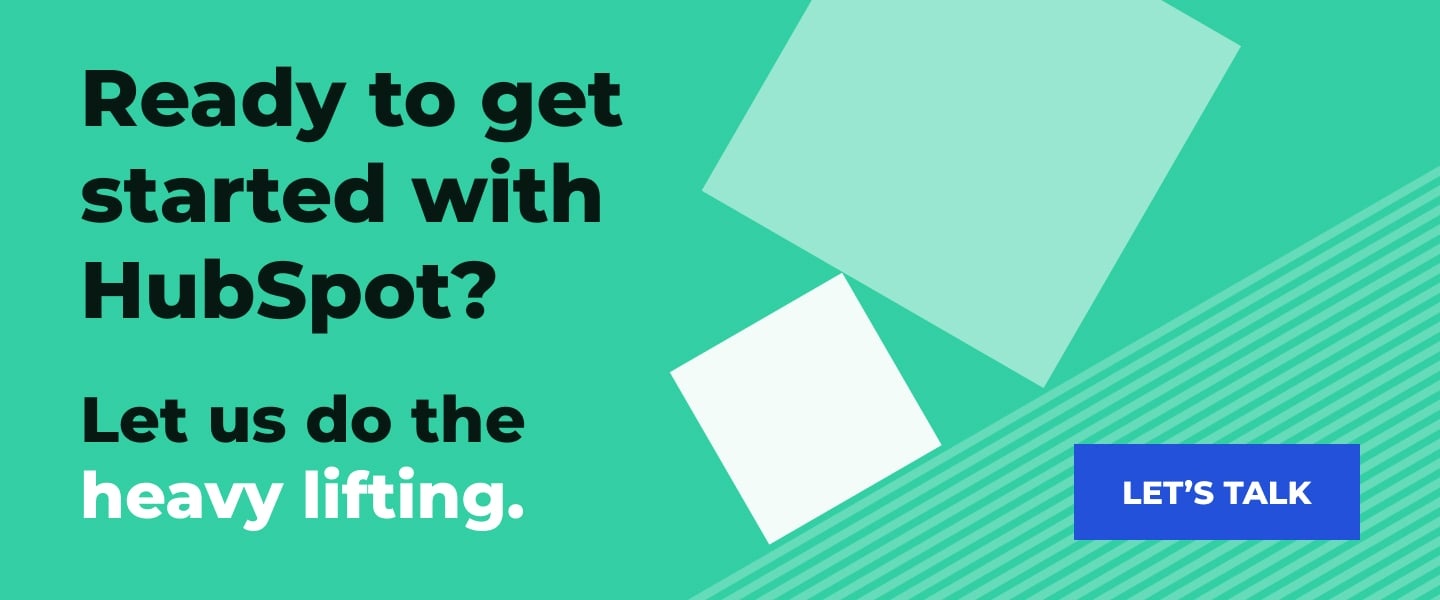More than half of sales people spend up to 10 hours a week on a CRM platform. That makes sense, because CRMs can boost sales by 29%. That’s quite a bit of revenue gained just by leveraging technology!
Considering how much a CRM can contribute to the revenue your sales team brings in, setting it up to run efficiently should be a high priority. You want to make sure you have the right tools and workflows in place to support an effective sales process.
We’re pretty fond of HubSpot as a sales tool, and we find that a lot of sales teams have questions about setting up HubSpot to manage their sales process, save time and increase their effectiveness in closing revenue.
If that’s you, we’re going to walk through how to build a sales pipeline in Hubspot that will not only keep you organized, but add in some efficiencies that will give your team more time to focus on what they do best—closing those deals.
? Download Your HubSpot Pipeline Cheat Sheet
Quick Reference of Terms We Will Use:
Deals – This is how HubSpot tracks potential revenue. Multiple contacts can be associated with a deal as well as one company.
Pipeline – Pipelines track the progress of a deal through the sales process, from creation to close. You can have multiple pipelines in your portal.
Stages – Stages are unique parts of your sales process within your pipeline. You may have a stage for “Demo Requested” or “Proposal Sent” or whatever makes the most sense for your team. You can add and subtract stages and they can all be customized for your organization’s needs.
Identify Reporting Needs
Reporting on sales performance is essential because you need to show how much revenue the team is bringing in to identify opportunities to improve. Not only that, accurate reporting allows you to see potential dips in sales before they happen, so you can address and mitigate them before you miss out on revenue.
Before you even outline your sales process and begin building your pipeline, you need to clearly outline your reporting needs. This will influence both the deal stages and the properties that are added to the deal record.
As you write out your reporting must-haves, think about a couple of things:
- How will you define lead sources in your pipeline? Do you already have a list of your inbound marketing channels that double as lead generators? Ideally, you want a broad list that includes 5-8 sources. Those sources might include things like referral partners, social channels, your website and events..
- What other information would help you cross-sell and upsell? Can you document things like a platform your prospect is using or the region they operate in? Are there capabilities or technologies that your prospects use that you should be tracking and reporting on?
- Do you know your likelihood to close a deal? Do you know when a deal becomes more likely to close?
Outline Your Buyer’s Journey and Sales Process
Your HubSpot sales pipeline will be based on the buyer’s journey you’ve mapped out for your prospects. Each stage in the pipeline will be a step toward sales that are closed, won or lost. This roadmap will help you better track, understand and qualify new leads as well as remove roadblocks from their journey.
First, you need to outline your sales process. This will serve as a guide when you build your pipeline. There are a few key considerations when deciding the steps in your process:
- What is the trigger for a prospect entering your pipeline? This will be your main lead generation source. It could be a face-to-face interaction with one of your salespeople or booking a call through the HubSpot CRM. Whatever you choose, it should be something that indicates a viable sales opportunity.
- What stages help you see the likelihood of closing deals? You might know that once you send a proposal, clients have a 50% chance of closing, but clients in a new deal stage only have 30-40% chance. This helps you focus the right amount of energy on leads based on where they are in your deals pipeline and the probability of closing.
- Do you need more than one pipeline? Some businesses opt to split pipelines between different sales teams. So the team that handles new business would have a separate pipeline than the team that handles renewals. This works well if you have a big team and find your pipeline gets easily cluttered with new leads and return customers.
Build Your Deal Stages
Now that you’ve outlined your sales process and reporting needs, you can start to work on your deal stages. We typically recommend having no more than eight or nine stages (including closed, won and lost). Any more than this and your pipeline becomes difficult to manage and ineffective.
Sometimes this isn’t so cut and dry. If you’re having trouble narrowing down your stages, it might be a sign you need multiple pipelines. An alternative to multiple pipelines is using custom properties to define specific sales activities in different stages. This can help you narrow the scope of each stage so it’s addressing a specific action or probability.
As you build your deal stages, you’ll also need to define the key indicators in your sales cycle that move a lead into the next stage. These should be obvious metrics that are easy to track and look at leads objectively.
Identify the Information You Need in Each Stage
At each stage in the sales process, there’s likely specific information your sales rep will need from qualified leads to move the deal forward. Whether this is through follow-up meetings or automated requests, you want to make sure your pipeline is set up with tools that will help you capture this information.
HubSpot offers a few ways to ensure the information you need is being consistently gathered by your sales people.
- Required Fields. In HubSpot, you can create required fields when a deal is moved to the next stage. This ensures that the critical information is either gathered by your team or submitted by leads at each stage.
- Snippets. Snippets help with more than just sales enablement, but in this case, they can automatically populate an outline for your notes during a call. For example, you can make a snippet for discovery calls with questions every salesperson should ask. They can add the responses to the document and save the answers for later use.
- Playbooks. Think of this as a starting template. A sales playbook gives your team a solid foundation to build on with each unique sale. Although not every sale is the same, having a playbook gives your team a solid starting point so they can spend their mental energy on determining and meeting a lead’s specific needs.
Automating Your Pipeline
Automation is the secret to easy, effective sales pipeline management and one of the reasons HubSpot is so attractive to teams. Automating as much of the process as possible frees up your time to find and close more deals, increase your win probability and create more consistency in your database.
Hubspot has some pretty extensive capabilities when it comes to automation, which makes it highly customizable to your business. Some common HubSpot automations include:
- Lifecycle stage updates
- Stage movement based on days since last activity
- Task creation if required information is missing that prompts team members to fill in the missing fields
- Notifications to other members of the sales and marketing teams at key moments in the sales process
Get Building!
When you thoughtfully build a sales pipeline in HubSpot, you can save your team a lot of time and increase your sales effectiveness which means MORE REVENUE *cue the church bells*. We know how difficult it can be to get people into your pipeline and move them through the sales funnel, so we’re here to help. If you have any questions about building a pipeline in HubSpot or just want to chat about ways to make it more efficient, give us a call! We’re a HubSpot Onboarding Accredited Partner and we love helping businesses build their HubSpot portals.
And if you didn’t grab it already, download our HubSpot Pipeline Cheat Sheet to make sure you get all the critical components in place.



